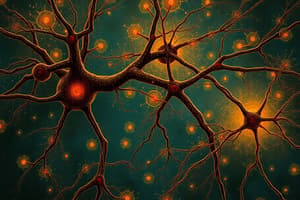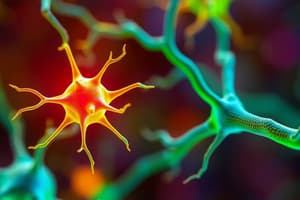Podcast
Questions and Answers
Match the part of the neuron with its function:
Match the part of the neuron with its function:
Dendrites = Receive signals from other neurons Soma = Cell body containing the nucleus Axon = Transmits signals away from the cell body Myelin Sheath = Insulates the axon for faster transmission
Match the type of neuron with its role:
Match the type of neuron with its role:
Sensory/Afferent neurons = Carry signals from sensory organs to the brain Motor/Efferent neurons = Transmit signals from the brain to muscles Interneurons = Connect sensory and motor neurons Glial cells = Support and protect neurons
Match the part of the brain with its function:
Match the part of the brain with its function:
Cerebellum = Coordination of movement and balance Pons = Aids in sleeping and arousal Medulla = Controls vital functions like heart rate Thalamus = Relays sensory signals to the cerebral cortex
Match the techniques with their description:
Match the techniques with their description:
Match the lobe of the brain with its primary function:
Match the lobe of the brain with its primary function:
Match the gland with its hormone:
Match the gland with its hormone:
Match the neuroplasticity concept with its explanation:
Match the neuroplasticity concept with its explanation:
Match the neurotransmitter with its role:
Match the neurotransmitter with its role:
Flashcards are hidden until you start studying
Study Notes
Neurons
- Neurons are the basic units of the nervous system
- Dendrites receive signals from other neurons
- Soma is the cell body of a neuron, containing the nucleus
- Axon transmits signals away from the soma
- Myelin sheath insulates the axon, speeding up signal transmission
- Axon terminals release neurotransmitters into the synapse
- Sensory (Afferent) Neurons transmit signals from sensory organs to the central nervous system
- Motor (Efferent) Neurons transmit signals from the central nervous system to muscles and glands
Neural Transmission
- Threshold is the level of stimulation needed to trigger an action potential
- Action potential is a brief electrical impulse that travels down the axon
- All-or-None Law states that an action potential either fires completely or not at all
- Synapse is the gap between the axon terminal of one neuron and the dendrite of another
- Neurotransmitters are chemical messengers that cross the synapse
- Dopamine: Associated with movement, attention, learning, and pleasure
- Serotonin: Associated with mood, sleep, appetite, and arousal
- Acetylcholine: Associated with muscle action, memory, and learning
- Maladaptations in neurotransmitter levels can lead to various disorders like Parkinson's disease, depression, and schizophrenia
Peripheral Nervous System
- The Peripheral Nervous System (PNS) is divided into the Somatic Nervous System and the Autonomic Nervous System
- The Somatic Nervous System controls voluntary movements of skeletal muscles
- The Autonomic Nervous System controls automatic functions like heart rate, digestion, and breathing
- The Sympathetic Nervous System prepares the body for action, "fight or flight" response.
- The Parasympathetic Nervous System calms the body, "rest and digest" response.
Cerebral Cortex (Forebrain)
- The Cerebral Cortex is the outer layer of the brain responsible for higher-level functions like language, memory, and reasoning
- Frontal lobes: Responsible for planning, decision-making, and motor control
- Temporal lobes: Responsible for auditory processing, memory, and language comprehension
- Parietal lobes: Responsible for sensory processing, spatial awareness, and attention
- Occipital lobes: Responsible for visual processing
- Motor cortex: Controls voluntary movements
- Somatosensory cortex: Receives sensory information from the body
- Broca's Area: Responsible for speech production
- Wernicke's Area: Responsible for language comprehension
Limbic System & Hindbrain
- The Limbic System is involved in emotions, motivation, and memory
- Hippocampus: Involved in the formation of new memories
- Amygdala: Involved in processing emotions, especially fear and aggression
- Hypothalamus: Regulates basic drives like hunger, thirst, and temperature
- The Hindbrain controls basic life functions
- Cerebellum: Coordinates movement, balance, and posture
- Pons: Connects the cerebellum to the rest of the brain
- Medulla: Controls breathing, heart rate, and blood pressure
Brain Imaging
- EEG (Electroencephalogram): Measures electrical activity in the brain, used to study sleep, epilepsy, and other brain disorders
- CT Scan (Computed Tomography): Uses X-rays to create images of brain structures
- MRI (Magnetic Resonance Imaging): Uses magnetic fields to create detailed images of brain structures, provides insights into brain anatomy.
- PET Scan (Positron Emission Tomography): Uses radioactive tracers to measure brain activity, useful for studying brain function and metabolism.
- fMRI (Functional Magnetic Resonance Imaging): Measures brain activity by detecting changes in blood flow, one of the most commonly used brain imaging techniques for studying cognition and behavior.
Endocrine System
- The Endocrine System is a network of glands that secrete hormones into the bloodstream
- Pituitary Gland: "Master gland," controls other endocrine glands
- Pineal Gland: Produces melatonin, regulates sleep-wake cycles
- Thyroid: Produces thyroxin, regulates metabolism
- Pancreas: Produces insulin and glucagon, regulate blood sugar levels
- Adrenal Glands: Produce adrenaline (epinephrine), involved in stress response
- Gonads (Ovaries & Testes): Produce sex hormones like estrogen and testosterone
- Estrogen: Associated with female sexual development and reproductive function
- Testosterone: Associated with male sexual development and reproductive function
- Oxytocin: Associated with bonding, love, and social trust
- Cortisol: The stress hormone, released during stressful situations
Studying That Suits You
Use AI to generate personalized quizzes and flashcards to suit your learning preferences.



